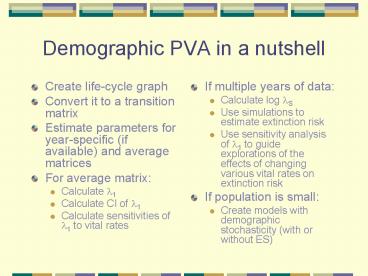Demographic PVA in a nutshell PowerPoint PPT Presentation
1 / 31
Title: Demographic PVA in a nutshell
1
Demographic PVA in a nutshell
- Create life-cycle graph
- Convert it to a transition matrix
- Estimate parameters for year-specific (if
available) and average matrices - For average matrix
- Calculate l1
- Calculate CI of l1
- Calculate sensitivities of l1 to vital rates
- If multiple years of data
- Calculate log lS
- Use simulations to estimate extinction risk
- Use sensitivity analysis of l1 to guide
explorations of the effects of changing various
vital rates on extinction risk - If population is small
- Create models with demographic stochasticity
(with or without ES)
2
If you find yourself doing a lot of demographic
analysis
- Learn Matlab or R
- Get Hal Caswells book
- Caswell, H. 2001. Matrix Population Models
Construction, Analysis, and Interpretation.
Sinauer Press, 722 pp.
3
Terminology for spatial PVA
- Site discrete patch of habitat that has some
potential to maintain the species - Local Population group of individuals living at
a site - Global (Multi-Site) Population individuals
living at all sites - Metapopulation multi-site population
characterized by frequent local extinction and
recolonization
4
Endpoints
- Probability of global extinction
- Importance of given population for global
persistence - Value of increasing or maintaining dispersal
between sites (e.g. through corridors)
5
Scenarios
- Independent populations
- Mainland-island
- One highly viable site
- Other sites depend on immigration from mainland
site - Archipelago
- All sites with moderate viability, some dispersal
- Metapopulation
- Local extinction frequent
- Recolonization by dispersers frequent
6
No dispersal
- If populations are independent then total
extinction probability is product of local
extinction probabilities - Positive spatial correlation in environmental
variables will increase overall extinction risk
7
Low dispersal
- Local population dynamics qualitatively unchanged
- Extinct sites can be recolonized
- Inbreeding effects reduced
8
High dispersal
- Substantial effect on local population dynamics
- Small local populations can be rescued
- Otherwise unviable local populations can be
maintained (source-sink dynamics) - Leads to spatial correlation in population size
9
(No Transcript)
10
Data requirements
- Population size or demography at each site
- What do we assume for sites where we dont have
data? - Spatial correlations in environmental variables
- Negative correlations different habitat types?
- Positive correlations environmental drivers,
tend to decline with distance - Dispersal rates among sites
- Factors influencing emigration and immigration
- Dispersal mortality
- Behavior in matrix (non-habitat)
- Connection probability tends to decline with
distance
11
Quantifying environmental correlation
- Correlation in population growth rates
- Correlation in vital rates
- Correlation in weather variables
- Spatial extent of catastrophic events
12
Clapper rail in SF Bay
13
Vital rate correlations
14
Rainfall correlations
15
Clapper rail viability no dispersal
16
Global viability depends on Mowry
17
Quantifying dispersal
- Mark-recapture data
- Examine distribution of distance moved
- Behavioral observations
- Movement models (e.g. random walk) allow
extrapolation from short-term measurements - Genetic data
- Decline in genetic similarity with distance
18
California gnatcatcher dispersal
19
Clapper rail with dispersal
20
Which grizzly pops are most important for
persistence?
21
Multi-site demographic PVA (no dispersal)
22
Multi-site demographic PVA (juvenile
dispersal)
23
Spatial PVA in practice
- Dont have demographic or count data from all
sites - Dont have good estimates of dispersal
- Dont have quantitative estimates of spatial
correlation - Do know something about location, size, and
relative quality of the sites - For a really good example, see
- Akçakaya, HR, JL Atwood. 1997. A habitat-based
metapopulation model of the California
Gnatcatcher. Conservation Biology 11422434. - http//www.blackwell-synergy.com/links/doi/10.1046
2Fj.1523-1739.1997.96164.x
24
Now for something completely different
- Suppose we know where all the sites of potential
habitat are - Its relatively easy to collect presence/absence
data (at least for non-cryptic species) - With multiple years of this, we can create a
patch-based metapopulation model - Focus on models by Illka Hanski
25
Incidence function model
- For each patch, need to know area, distance to
all other patches - Extinction and colonization are patch specific
- Extinction depends on patch area
26
Colonization
- Colonization probability is saturating function
of number of immigrants - Immigrants are more likely to come from large,
close populations
27
Probability of occupancy (incidence function)
- At equilibrium, so some
algebra reveals
28
Parameter estimation
- Data consists of annual surveys of presence or
absence of species in every habitat patch - Single survey fit incidence function to observed
occupancy using nonlinear logistic regression - Multiple surveys fit extinction colonization
functions to observed extinctions colonizations
using nonlinear logistic regression
29
Simulating the metapopulation
- For each patch, calculate Ei and Ci(t)
- For each occupied patch, draw random number
(uniform on 0,1) to compare with Ei - If extinction occurs, draw another random number
to compare with Ci(t) rescue effect - For each unoccupied patch, draw random number to
compare with Ci(t) - Update patch status
30
Glanville fritillary metapopulation
31
Habitat loss metapopulation extinction

